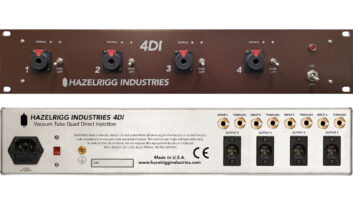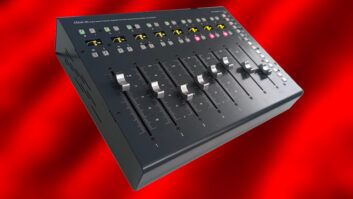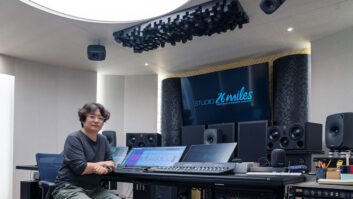Applied Research and Technology has two new desktop recordingunits that provide the necessary links from the analog world toyour workstation or digital tape deck. Expanding on the originalTube MP, the Tube MP Studio is a single-channel mic preamp/directbox with VU meter and peak limiter. The DI/O is a stereo, 24-bitand up to 96kHz AD/DA converter with 128x oversampling. Both unitsare packaged in small, 1.5-lbs. desktop boxes measuring 5×5.5x2inches (DxWxH) and use 12AX7A dual-triode vacuum tubes powered by9VAC wall wart supplies.
TUBE MP STUDIO
The Tube MP Studio has a lighted VU meter for monitoring boththe output level and the action of the output peak limiter (OPL)circuit. A bicolored LED glows green with low-level mic signalspresent and turns red when the tube’s output is either about toclip or when the OPL limits the signal. The MP Studio has XLR and?-inch I/O connections, a phase reverse switch and +48-volt phantompowering for condenser mics.
Using the Tube MP Studio with a Shure KSM44 mic provided goodresults. This gave a clear, clean sound without harshness in thetop end. Plugging an electric guitar into the ?-inch jack turnedthe unit into an instant direct box. The direct sound compared witha FET-based direct box was clean, without coloration orcompression. The Input Level Control sets gain from 6 to 40 dB orin High mode, 26 to 60 dB. The Equivalent Input Noise (EIN) is -129dBu (A-weighted). By deliberately overdriving the input for alittle tube distortion, you can still adjust the final output levelwith the Output Level control. Maximum output level is animpressive 28 dBu into 600 ohms. The Output Peak Limiter uses aFET-based peak limiter to control output peak levels. With the OPLactive, the output level is limited to 0 dBu at the ?-inch outputjack and 6 dBu at the XLR output. The attack time is internally setto very fast, while the release time is set to slow. These presetsworked well for most situations and contributed to the overallsound of this cool little box.
The Tube MP Studio is designed to sit next to your computerkeyboard for easy access. But I found that in the High Gain mode, Ihad some increased noise and interference caused by my computer’smonitor. After I moved the MP a little further away, all noisestopped. Using the OPL is simple: Just crank up the Input controland you’ll see the red LED light up more and more. The limiteraction is very affirmative: an absolute peak clamp! On onerecording, I used it as an effect and loved it. The sound of thisbrickwall limiter is reason enough for me to own the MP.
THE DI/O
The DI/O has stereo analog inputs and outputs, 24-bit S/PDIFdigital input and output connections, and switchable 44.1, 48, 88.2and 96kHz sample rates. The unit will also sync to external digitalsystems automatically in External mode. Multichannel workstationusers will use this mode, because you’ll want to sync with the restof your A/D converters. The D/A converter synchs to incoming audioup to 100kHz sample rates and will mute audio if something iswrong. However, this action does not affect A/D conversion.
DI/O’s simple front panel has an input gain for adjusting analogaudio levels from 0 to 20 dB. The 12AX7 tube in the DI/O’s signalpath can be adjusted with the Tube Warmth control to add characterto the A/D conversion. The control ranges from a very clean andpristine sound to a more warm and fuzzy nature. At higher tubewarmth settings, a yellow LED lights to show saturation of thetube; the same LED moves up to red when the A/D is three dB fromclipping. Sample rate is selected with a Function Tree pushbutton:Just push it until the right combination of LEDs light up,indicating your desired sample rate.
Using both the DI/O and Tube MP units together (they stack onone another), I can skip the analog front end of my cheap soundcardby going through the S/PDIF ports. The DI/O’s D/A converter wasbetter than the one in my old DAT machine. On another session, Itried plugging the analog output of the D/A converter into theanalog input of the A/D converter. As silly as this sounds, I wasable to add a tubey sound to an already recorded Pro Toolsfile.
The DI/O is a great portable stereo AD/DA converter that soundsdifferent enough from your other converters to make it more thanworth its $249 MSRP. The ART Tube MP Studio is $159; both unitsinclude one-year warranties.
ART, 215 Tremont St., Rochester, NY 14608; 716/436-2720; fax716/436-3942; www.artproaudio.com.
Barry Rudolph is an L.A.-based recording engineer. Visit his Website at www.barryrudolph.com.
SPEC SHEET







